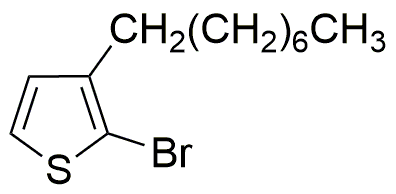2-Bromo-3-n-octylthiophene is widely utilized in research focused on:
- Organic Electronics: This compound serves as a key building block in the development of organic semiconductors, which are essential for creating flexible and lightweight electronic devices such as organic light-emitting diodes (OLEDs) and organic photovoltaics (OPVs).
- Conductive Polymers: It is used to synthesize conductive polymers that can be applied in various fields, including sensors and energy storage devices, enhancing their conductivity and overall performance.
- Photovoltaic Applications: Researchers leverage its properties to improve the efficiency of solar cells, making renewable energy solutions more viable and effective.
- Materials Science: The compound is explored for its potential in developing advanced materials with tailored electronic properties, which can be beneficial in creating next-generation electronic components.
- Research in Organic Chemistry: It serves as a valuable reagent for synthesizing other complex organic molecules, facilitating advancements in chemical research and development.
Información general
Propiedades
Seguridad y normativas
Aplicaciones
2-Bromo-3-n-octylthiophene is widely utilized in research focused on:
- Organic Electronics: This compound serves as a key building block in the development of organic semiconductors, which are essential for creating flexible and lightweight electronic devices such as organic light-emitting diodes (OLEDs) and organic photovoltaics (OPVs).
- Conductive Polymers: It is used to synthesize conductive polymers that can be applied in various fields, including sensors and energy storage devices, enhancing their conductivity and overall performance.
- Photovoltaic Applications: Researchers leverage its properties to improve the efficiency of solar cells, making renewable energy solutions more viable and effective.
- Materials Science: The compound is explored for its potential in developing advanced materials with tailored electronic properties, which can be beneficial in creating next-generation electronic components.
- Research in Organic Chemistry: It serves as a valuable reagent for synthesizing other complex organic molecules, facilitating advancements in chemical research and development.
Documentos
Hojas de datos de seguridad (HDS)
La SDS proporciona información de seguridad completa sobre la manipulación, el almacenamiento y la eliminación del producto.
Especificación del producto (PS)
La PS proporciona un desglose completo de las propiedades del producto, incluida la composición química, el estado físico, la pureza y los requisitos de almacenamiento. También detalla los rangos de calidad aceptables y las aplicaciones previstas del producto.
Certificados de análisis (COA)
Busque certificados de análisis (COA) ingresando el número de lote del producto. Los números de lote y de partida se pueden encontrar en la etiqueta de un producto después de las palabras "Lote" o "Lote".
Número de catálogo
Número de lote/lote
Certificados de origen (COO)
Este certificado de origen confirma el país en el que se fabricó el producto y también detalla los materiales y componentes utilizados en él y si se deriva de fuentes naturales, sintéticas u otras fuentes específicas. Este certificado puede ser necesario para cumplir con las normativas aduaneras, comerciales y regulatorias.
Número de catálogo
Número de lote/lote
Hojas de datos de seguridad (HDS)
La SDS proporciona información de seguridad completa sobre la manipulación, el almacenamiento y la eliminación del producto.
DownloadEspecificación del producto (PS)
La PS proporciona un desglose completo de las propiedades del producto, incluida la composición química, el estado físico, la pureza y los requisitos de almacenamiento. También detalla los rangos de calidad aceptables y las aplicaciones previstas del producto.
DownloadCertificados de análisis (COA)
Busque certificados de análisis (COA) ingresando el número de lote del producto. Los números de lote y de partida se pueden encontrar en la etiqueta de un producto después de las palabras "Lote" o "Lote".
Número de catálogo
Número de lote/lote
Certificados de origen (COO)
Este certificado de origen confirma el país en el que se fabricó el producto y también detalla los materiales y componentes utilizados en él y si se deriva de fuentes naturales, sintéticas u otras fuentes específicas. Este certificado puede ser necesario para cumplir con las normativas aduaneras, comerciales y regulatorias.


